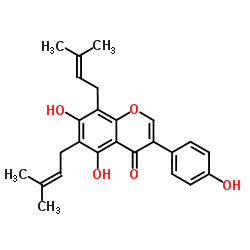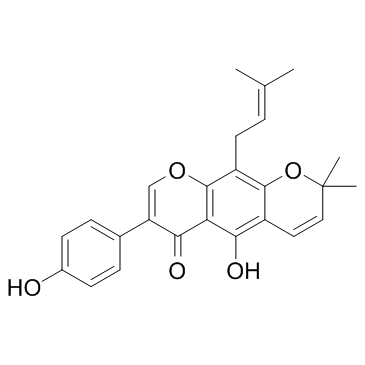482-53-1
| 中文名 | 奥沙京 |
|---|---|
| 英文名 | osajin |
| 英文别名 |
UNII-83R5N9X74B
5-Hydroxy-3-(4-hydroxyphenyl)-8,8-dimethyl-6-(3-methyl-2-butenyl)-4H,8H-benzo[1,2-b:3,4-b']dipyran-4-one 5-Hydroxy-3-(4-hydroxyphenyl)-8,8-dimethyl-6-(3-methyl-2-buten-1-yl)-4H,8H-pyrano[2,3-f]chromen-4-one osajin |
| 描述 | Osajin是 Maclura pomifera 果实中存在的主要生物活性异氟烷,具有抗肿瘤,抗氧化和抗炎活性。 |
|---|---|
| 相关类别 | |
| 靶点 |
Apoptosis[1] |
| 体外研究 | Osajin以剂量依赖性方式显着降低人NPC细胞(TW076,CG1和TW04细胞)的活力。 Osajin通过多种凋亡途径诱导人NPC细胞凋亡,包括外在死亡受体途径,以及依赖线粒体和内质网应激的内在途径[1]。 Osajin对六种人类癌细胞系具有生长抑制活性,包括肾,肺,前列腺,乳腺癌,黑色素瘤和结肠癌细胞[2]。 |
| 体内研究 | Osajin和pomiferin可减轻缺血再灌注引起的心肌功能障碍。抗氧化酶值和总抗氧化活性的增加证实了这一点。 osajin和pomiferin治疗提供的心脏保护作用来自抑制氧化应激,这与改善的心室功能相关[3]。 |
| 细胞实验 | 将NPC细胞接种在96孔板(5000个/孔)中并使其粘附24小时。然后用含有不同浓度(0.01-10μM)osajin的新鲜培养基替换培养基另外24小时。对于时程测定,5μMosajin的孵育时间为6,12,24,36和48小时。温育后,向每个孔中加入10μl5mg/ ml的MTT,并在37℃下孵育4小时。使用基于MTT的测定确定细胞活力[1]。 |
| 动物实验 | 大鼠[1] Wistar大鼠分为四组。第一个治疗组接受osajin(5%/ kg /天,0.5%Avicel);第二治疗组接受pomiferin(0.5 mg Avicel中5 mg / kg /天);安慰剂组仅获得0.5 Avicel;最后一个是未经治疗的对照组。评价氧化损伤的生化指标 - 脂质过氧化产物丙二醛,抗氧化酶 - 超氧化物歧化酶,谷胱甘肽过氧化物酶,血清和心肌中的总抗氧化活性。研究了osajin和pomiferin对心功能,左心室舒张末压,左心室压力和峰值阳性+ dP / dt缺血再灌注的影响[1]。 |
| 参考文献 |
| 密度 | 1.3±0.1 g/cm3 |
|---|---|
| 沸点 | 632.3±55.0 °C at 760 mmHg |
| 熔点 | 189° (uncorr), 193° (corr) |
| 分子式 | C25H24O5 |
| 分子量 | 404.455 |
| 闪点 | 218.7±25.0 °C |
| 精确质量 | 404.162384 |
| PSA | 79.90000 |
| LogP | 7.62 |
| 外观性状 | 黄色粉末 |
| 蒸汽压 | 0.0±1.9 mmHg at 25°C |
| 折射率 | 1.628 |
| 储存条件 | ?20°C |
|
SECTION 1: Identification of the substance/mixture and of the company/undertaking Product identifiers Product name: Osajin REACH No.: A registration number is not available for this substance as the substance or its uses are exempted from registration, the annual tonnage does not require a registration or the registration is envisaged for a later registration deadline.
CAS-No.: 482-53-1 Relevant identified uses of the substance or mixture and uses advised against Identified uses: Laboratory chemicals, Manufacture of substances SECTION 2: Hazards identification Classification of the substance or mixture Classification according to Regulation (EC) No 1272/2008 Acute aquatic toxicity (Category 1), H400 Chronic aquatic toxicity (Category 1), H410 For the full text of the H-Statements mentioned in this Section, see Section 16. Classification according to EU Directives 67/548/EEC or 1999/45/EC N Dangerous for theR50 environment For the full text of the R-phrases mentioned in this Section, see Section 16. Label elements Labelling according Regulation (EC) No 1272/2008 Pictogram Signal wordWarning Hazard statement(s) H410Very toxic to aquatic life with long lasting effects. Precautionary statement(s) P273Avoid release to the environment. P501Dispose of contents/ container to an approved waste disposal plant. Supplemental Hazardnone Statements Other hazards - none SECTION 3: Composition/information on ingredients Substances Molecular Weight: 404,46 g/mol CAS-No.: 482-53-1 Hazardous ingredients according to Regulation (EC) No 1272/2008 ComponentClassificationConcentration Osajin Aquatic Acute 1; Aquatic- Chronic 1; H410 Hazardous ingredients according to Directive 1999/45/EC ComponentClassificationConcentration Osajin N, R50- For the full text of the H-Statements and R-Phrases mentioned in this Section, see Section 16 SECTION 4: First aid measures Description of first aid measures General advice Consult a physician. Show this safety data sheet to the doctor in attendance. If inhaled If breathed in, move person into fresh air. If not breathing, give artificial respiration. Consult a physician. In case of skin contact Wash off with soap and plenty of water. Consult a physician. In case of eye contact Flush eyes with water as a precaution. If swallowed Never give anything by mouth to an unconscious person. Rinse mouth with water. Consult a physician. Most important symptoms and effects, both acute and delayed The most important known symptoms and effects are described in the labelling (see section 2.2) and/or in section 11 Indication of any immediate medical attention and special treatment needed no data available SECTION 5: Firefighting measures Extinguishing media Suitable extinguishing media Use water spray, alcohol-resistant foam, dry chemical or carbon dioxide. Special hazards arising from the substance or mixture no data available Advice for firefighters Wear self contained breathing apparatus for fire fighting if necessary. Further information no data available SECTION 6: Accidental release measures Personal precautions, protective equipment and emergency procedures Avoid dust formation. Avoid breathing vapours, mist or gas. Ensure adequate ventilation. For personal protection see section 8. Environmental precautions Prevent further leakage or spillage if safe to do so. Do not let product enter drains. Discharge into the environment must be avoided. Methods and materials for containment and cleaning up Pick up and arrange disposal without creating dust. Sweep up and shovel. Keep in suitable, closed containers for disposal. Reference to other sections For disposal see section 13. SECTION 7: Handling and storage Precautions for safe handling Provide appropriate exhaust ventilation at places where dust is formed. For precautions see section 2.2. Conditions for safe storage, including any incompatibilities Store in cool place. Keep container tightly closed in a dry and well-ventilated place. Recommended storage temperature: -20 °C Specific end use(s) A part from the uses mentioned in section 1.2 no other specific uses are stipulated SECTION 8: Exposure controls/personal protection Control parameters Components with workplace control parameters Exposure controls Appropriate engineering controls Handle in accordance with good industrial hygiene and safety practice. Wash hands before breaks and at the end of workday. Personal protective equipment Eye/face protection Use equipment for eye protection tested and approved under appropriate government standards such as NIOSH (US) or EN 166(EU). Skin protection Handle with gloves. Gloves must be inspected prior to use. Use proper glove removal technique (without touching glove's outer surface) to avoid skin contact with this product. Dispose of contaminated gloves after use in accordance with applicable laws and good laboratory practices. Wash and dry hands. The selected protective gloves have to satisfy the specifications of EU Directive 89/686/EEC and the standard EN 374 derived from it. Body Protection Choose body protection in relation to its type, to the concentration and amount of dangerous substances, and to the specific work-place., The type of protective equipment must be selected according to the concentration and amount of the dangerous substance at the specific workplace. Respiratory protection Respiratory protection is not required. Where protection from nuisance levels of dusts are desired, use type N95 (US) or type P1 (EN 143) dust masks. Use respirators and components tested and approved under appropriate government standards such as NIOSH (US) or CEN (EU). Control of environmental exposure Prevent further leakage or spillage if safe to do so. Do not let product enter drains. Discharge into the environment must be avoided. SECTION 9: Physical and chemical properties Information on basic physical and chemical properties a) AppearanceForm: solid b) Odourno data available c) Odour Thresholdno data available d) pHno data available e) Melting point/freezing194 °C point f) Initial boiling point and no data available boiling range g) Flash pointno data available h) Evapouration rateno data available i) Flammability (solid, gas) no data available j) Upper/lowerno data available flammability or explosive limits k) Vapour pressureno data available l) Vapour densityno data available m) Relative densityno data available n) Water solubilityno data available o) Partition coefficient: n- log Pow: 5,599 octanol/water p) Auto-ignitionno data available temperature q) Decompositionno data available temperature r) Viscosityno data available s) Explosive propertiesno data available t) Oxidizing propertiesno data available Other safety information no data available SECTION 10: Stability and reactivity Reactivity no data available Chemical stability Stable under recommended storage conditions. Possibility of hazardous reactions no data available Conditions to avoid no data available Incompatible materials Strong oxidizing agents Hazardous decomposition products Other decomposition products - no data available In the event of fire: see section 5 SECTION 11: Toxicological information Information on toxicological effects Acute toxicity no data available Skin corrosion/irritation no data available Serious eye damage/eye irritation no data available Respiratory or skin sensitisation no data available Germ cell mutagenicity no data available Carcinogenicity IARC:No component of this product present at levels greater than or equal to 0.1% is identified as probable, possible or confirmed human carcinogen by IARC. Reproductive toxicity no data available Specific target organ toxicity - single exposure no data available Specific target organ toxicity - repeated exposure no data available Aspiration hazard no data available Additional Information RTECS: Not available To the best of our knowledge, the chemical, physical, and toxicological properties have not been thoroughly investigated. SECTION 12: Ecological information Toxicity no data available Persistence and degradability no data available Bioaccumulative potential no data available Mobility in soil no data available Results of PBT and vPvB assessment PBT/vPvB assessment not available as chemical safety assessment not required/not conducted Other adverse effects Very toxic to aquatic life with long lasting effects. no data available SECTION 13: Disposal considerations Waste treatment methods Product Offer surplus and non-recyclable solutions to a licensed disposal company. Dissolve or mix the material with a combustible solvent and burn in a chemical incinerator equipped with an afterburner and scrubber. Contaminated packaging Dispose of as unused product. SECTION 14: Transport information UN number ADR/RID: 3077IMDG: 3077IATA: 3077 UN proper shipping name ADR/RID: ENVIRONMENTALLY HAZARDOUS SUBSTANCE, SOLID, N.O.S. (Osajin) IMDG: ENVIRONMENTALLY HAZARDOUS SUBSTANCE, SOLID, N.O.S. (Osajin) IATA:Environmentally hazardous substance, solid, n.o.s. (Osajin) Transport hazard class(es) ADR/RID: 9IMDG: 9IATA: 9 Packaging group ADR/RID: IIIIMDG: IIIIATA: III Environmental hazards ADR/RID: yesIMDG Marine pollutant: yesIATA: yes Special precautions for user Further information EHS-Mark required (ADR 2.2.9.1.10, IMDG code 2.10.3) for single packagings and combination packagings containing inner packagings with Dangerous Goods > 5L for liquids or > 5kg for solids. SECTION 15 - REGULATORY INFORMATION N/A SECTION 16 - ADDITIONAL INFORMATION N/A |
| 符号 |

GHS09 |
|---|---|
| 信号词 | Warning |
| 危害声明 | H410 |
| 警示性声明 | P273-P501 |
| 危害码 (欧洲) | N |
| 风险声明 (欧洲) | 50 |
| 安全声明 (欧洲) | 61 |
| 危险品运输编码 | UN 3077 9 / PGIII |
| 上游产品 1 | |
|---|---|
| 下游产品 2 | |






![5-methoxy-3-(4-methoxyphenyl)-8,8-dimethyl-6-(3-methylbut-2-enyl)pyrano[2,3-h]chromen-4-one结构式](https://image.chemsrc.com/caspic/443/5254-72-8.png)